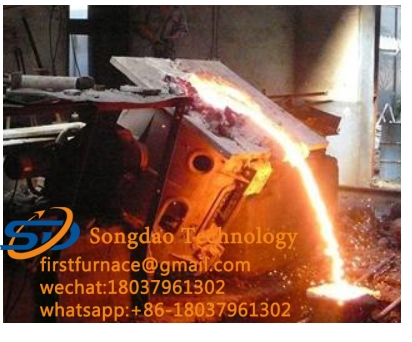- 01
- Mar
ઇન્ડક્શન મેલ્ટિંગ ફર્નેસ માટે પાંચ સામાન્ય મુશ્કેલીનિવારણ પદ્ધતિઓ
ઇન્ડક્શન મેલ્ટિંગ ફર્નેસ માટે પાંચ સામાન્ય મુશ્કેલીનિવારણ પદ્ધતિઓ
(1) The power supply of the induction melting furnace: Use a multimeter to check whether there is electricity behind the main circuit switch (contactor) and the control fuse, which will rule out the possibility of disconnection of these components.

(2) Rectifier of induction melting furnace: The rectifier uses a three-phase fully controlled bridge rectifier circuit, which includes six fast fuses, six thyristors, six pulse transformers and a freewheeling diode.
There is a red indicator on the quick-acting fuse. Normally, the indicator is retracted inside the shell. When the quick-acting blows, it will pop up. Some quick-acting indicators are tight. When the quick-acting blows, it will get stuck inside. , So for the sake of reliability, you can use a multimeter to test the fast-blow on/off gear to determine whether it is blown.
The simple way to measure the thyristor is to use a multimeter to measure its cathode-anode and gate-cathode resistance with a multimeter (200Ω block). The thyristor does not need to be removed during the measurement. Under normal circumstances, the anode-cathode resistance should be infinite, and the gate-cathode resistance should be between 10-50Ω. Too large or too small indicates that the gate of this thyristor fails, and it cannot be triggered to conduct.
The secondary side of the pulse transformer is connected to the thyristor, and the primary side is connected to the main control board. Use a multimeter to measure the primary resistance of about 50Ω. The freewheeling diode is generally not prone to failure. Use a multimeter diode to measure its two ends during inspection. The multimeter shows that the junction voltage drop is about 500mV in the forward direction, and the reverse direction is blocked.
(3) Inverter of induction melting furnace: The inverter includes four fast thyristors and four pulse transformers, which can be inspected according to the above methods.
(4) ઇન્ડક્શન મેલ્ટિંગ ફર્નેસના ટ્રાન્સફોર્મર્સ: દરેક ટ્રાન્સફોર્મરની દરેક વિન્ડિંગ જોડાયેલ હોવી જોઈએ. સામાન્ય રીતે, પ્રાથમિક બાજુનો પ્રતિકાર દસ ઓહ્મ જેટલો હોય છે, અને ગૌણ પ્રતિકાર થોડા ઓહ્મ જેટલો હોય છે. એ નોંધવું જોઈએ કે મધ્યવર્તી આવર્તન વોલ્ટેજ ટ્રાન્સફોર્મરની પ્રાથમિક બાજુ લોડ સાથે સમાંતર રીતે જોડાયેલ છે, તેથી તેનું પ્રતિકાર મૂલ્ય શૂન્ય છે.
(5) ઇન્ડક્શન મેલ્ટિંગ ફર્નેસના કેપેસિટર્સ: લોડ સાથે સમાંતર રીતે જોડાયેલા ઇલેક્ટ્રિક હીટિંગ કેપેસિટર્સ તૂટી શકે છે. કેપેસિટર સામાન્ય રીતે કેપેસિટર રેક પર જૂથોમાં સ્થાપિત થાય છે. તૂટેલા કેપેસિટર્સનું જૂથ નિરીક્ષણ દરમિયાન પ્રથમ નક્કી કરવું જોઈએ. કેપેસિટરના દરેક જૂથના બસ બાર અને મુખ્ય બસ બાર વચ્ચેના જોડાણ બિંદુને ડિસ્કનેક્ટ કરો અને કેપેસિટરના દરેક જૂથના બે બસ બાર વચ્ચેના પ્રતિકારને માપો. સામાન્ય રીતે, તે અનંત હોવું જોઈએ. ખરાબ જૂથની પુષ્ટિ કર્યા પછી, બસ બાર તરફ દોરી જતા દરેક ઇલેક્ટ્રિક હીટિંગ કેપેસિટરની નરમ કોપર ત્વચાને ડિસ્કનેક્ટ કરો અને તૂટેલા કેપેસિટરને શોધવા માટે એક પછી એક તપાસો. દરેક ઇલેક્ટ્રિક હીટિંગ કેપેસિટર ચાર કોરોથી બનેલું છે. શેલ એક ધ્રુવ છે, અને બીજા ધ્રુવને ચાર ઇન્સ્યુલેટર દ્વારા અંતિમ કેપ તરફ દોરી જાય છે. સામાન્ય રીતે, માત્ર એક કોર તૂટી જશે. કેપેસિટરનો ઉપયોગ ચાલુ રાખી શકાય છે, અને તેની ક્ષમતા મૂળના 3/4 છે. કેપેસિટરનો બીજો દોષ તેલ લિકેજ છે, જે સામાન્ય રીતે ઉપયોગને અસર કરતું નથી, પરંતુ આગ નિવારણ પર ધ્યાન આપો.
